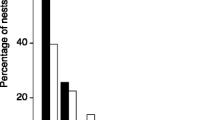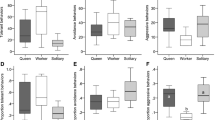Abstract
In eusocial nests, colony task are divided among queens and workers, but how this division of labor develops is unknown for most species. We compared division of labor and aggressive behavior among queens and workers in the facultatively eusocial bee, Megalopta genalis, using nests with established queen-worker pairs and nests in which the incipient worker had recently emerged. We find that the majority of aggression is directed from queens toward workers in both incipient and established relationships. Established workers forage and perform trophallaxis as donors more frequently than queens, but both queens and workers perform trophallaxis as donors when workers are young. Queens spend significantly more time nest guarding than incipient and established workers, perhaps because older workers spend more time foraging and incipient workers spend significantly more time in cells than do queens. Our results show that the development of worker behavior involves dynamic temporal changes in task performance among queens and workers during the 10 days after worker emergence. During this establishment period, queens engage in maternal care by feeding their daughters, but are also aggressive toward them. This may be a mechanism by which queens coerce their daughters into becoming non-reproductive workers.

Similar content being viewed by others
References
Altmann J (1974) Observational study of behavior—sampling methods. Behaviour 49:227–267
Arneson L, Wcislo WT (2003) Dominant-subordinate relationships in a facultatively social, nocturnal bee, Megalopta genalis (Hymenoptera: Halictidae). J Kans Entomol Soc 76:183–193
Batra S (1964) Behavior of the social bee, Lasioglossum zephyrum, within the nest (Hymenoptera: Halictidae). Insect Soc 11:159–185
Batra SWT (1966) Nests and social behavior of halictine bees of India (Hymenoptera: Halictidae). Indian J Entomol 28:375–393
Batra SWT (1968) Behavior of some social and solitary halictine bees within their nests: a comparative study (Hymenoptera: Halictidae). J Kans Entomol Soc 41:120–133
Bell WJ (1973) Factors controlling initiation of vitellogenesis in a primitively social bee, Lasioglossum zephyrum (Hymenoptera: Halictidae). Insect Soc 20:253–260
Bell W, Breed M, Richards K, Michener C (1974) Social, stimulatory and motivational factors involved in intraspecific nest defense of a primitively eusocial halictine bee. J Comp Phys A 93:173–181
Boesi R, Polidori C, Andrietti F (2009) Biology of Lasioglossum (L.) majus (Hymenoptera: Halictidae), a largely solitary sweat bee with behavioural adaptations to communality. J Ethol 27:361–367
Breed MD, Gamboa GJ (1977) Behavioral control of workers by queens in primitively eusocial bees. Science 195:694–696
Brothers DJ, Michener CD (1974) Interactions in colonies of primitively social bees III. Ethometry of division of labor in Lasioglossum zephyrum (Hymenoptera: Halictidae). J Comp Phys A 90:129–168
Buckle GR (1982a) Differentiation of queens and nestmate interactions in newly established colonies of Lasioglossum zephyrum (Hymenoptera: Halictidae). Sociobiology 7:8–20
Buckle GR (1982b) Queen-worker behavior and nesmate interactions in young colonies of Lasioglossum zephyrum. Insect Soc 29:125–137
Dew RM, Gardner MG, Schwarz MP (2014) The problems of a priori categorisation of agonism and cooperation: circle-tube interactions in two allodapine bees. Ethology 120:551–562
Dew RM, Tierney SM, Schwarz MP (2015) Social evolution and casteless societies: needs for new terminology and a new evolutionary focus. Insect Soc. doi:10.1007/s00040-015-0435-1
Kapheim KM, Smith AR, Ihle KE, Amdam GV, Nonacs P, Wcislo WT (2012) Physiological variation as a mechanism for developmental caste-biasing in a facultatively eusocial sweat bee. Proc R Soc Lond B Biol Sci 279:1437–1446
Kapheim KM, Smith AR, Nonacs P, Wcislo WT, Wayne RK (2013) Foundress polyphenism and the origins of eusociality in a facultatively eusocial sweat bee, Megalopta genalis (Halictidae). Behav Ecol Sociobiol 67:331–340
Kapheim KM, Nonacs P, Smith AR, Wayne RK, Wcislo WT (2015) Kinship, parental manipulation and evolutionary origins of eusociality. Proc R Soc Lond B Biol Sci 282:20142886
Kukuk PF (1980) Diurnal activity of a primitively eusocial bee, Lasioglossum zephyrum, within the nest. J Kans Entomol Soc 53:149–156
Kukuk PF, Crozier RH (1990) Trophallaxis in a communal halictine bee Lasioglossum (Chilalictus) erythrurum. Proc Natl Acad Sci USA 87:5402–5404
Kukuk PF, May B (1991) Colony dynamics in a primitively eusocial halictine bee Lasioglossum (Dialictus) zephyrum (Hymenoptera: Halictidae). Insect Soc 38:171–189
McConnell-Garner J, Kukuk PF (1997) Behavioral interactions of two solitary, halictine bees with comparisons among solitary, communal and eusocial species. Ethology 103:19–32
Michener CD (1990) Reproduction and castes in social halictine bees. Social insects: an evolutionary approach to castes and reproduction. W. Engels. Springer, New York, pp 77–121
Michener CD, Brothers DJ (1974) Were workers of eusocial hymenoptera initially altruistic or oppressed? Proc Natl Acad Sci USA 71:671–674
Pabalan N, Davey K, Packer L (2000) Escalation of aggressive interactions during staged encounters in Halictus ligatus Say (Hymenoptera: Halictidae), with a comparison of circle tube behaviors with other halictine species. J Insect Behav 13:627–650
Packer L (2005) The influence of marking upon bee behaviour in circle tube experiments with a methodological comparison among studies. Insect Soc 52:139–146
Smith AR, Wcislo WT, O’Donnell S (2003) Assured fitness returns favor sociality in a mass-provisioning sweat bee, Megalopta genalis (Hymenoptera: Halictidae). Behav Ecol Sociobiol 54:14–21
Smith AR, Wcislo WT, O’Donnell S (2007) Survival and productivity benefits to social nesting in the sweat bee Megalopta genalis (Hymenoptera: Halictidae). Behav Ecol Sociobiol 61:1111–1120
Smith AR, Kapheim KM, O’Donnell S, Wcislo WT (2009) Social competition but not subfertility leads to a division of labour in the facultatively social sweat bee Megalopta genalis (Hymenoptera: Halictidae). Anim Behav 78:1043–1050
Smith AR, Kapheim KM, Perez-Ortega B, Brent CS, Wcislo WT (2013) Juvenile hormone levels reflect social opportunities in the facultatively eusocial sweat bee Megalopta genalis (Hymenoptera: Halictidae). Horm Behav 63:1–4
Wcislo WT (1997) Social interactions and behavioral context in a largely solitary bee, Lasioglossum (Dialictus) figueresi (Hymenoptera: Halictidae). Insect Soc 44:199–208
Wcislo WT, Gonzalez VH (2006) Social and ecological contexts of trophallaxis in facultatively social sweat bees, Megalopta genalis and M. ecuadoria (Hymenoptera: Halictidae). Insect Soc 53:220–225
Wcislo WT, Arneson L, Roesch K, Gonzalez V, Smith A, Fernandez H (2004) The evolution of nocturnal behaviour in sweat bees, Megalopta genalis and M. ecuadoria (Hymenoptera: Halictidae): An escape from competitors and enemies? Biol J Linn Soc 83:377–387
Acknowledgments
We thank M. Lopez-Uribe, M. Reiser, R. Cossio, D. La Rosa, J. Medina Gutierrez, S. Bernal, D. Ramirez Garcia, T. Alvey for field assistance; T. Innocent for help in designing the ethogram; A. Lee, C. Sheridan, H. Denenberg, S. Dao, F. Choe, A. Bird, A. Espinosa, E. Anderson, R. Parks for help in scoring the videos; O. Acevedo, B. Jimenez, O. Arosemena, for logistical support. Research on BCI was conducted under A.N.A.M. permit # SEX/A-34-09. K.M.K was supported by funds from NSF DDIG-0808256, Smithsonian Tropical Research Institute (STRI), Smithsonian Institution, UCLA, AWIS, U.S. Dept. Ed. K.M.K and P.N. were supported by NSF grant IOS-0642085. W.T.W. and A.R.S. were supported by STRI and SENACYT grant COL-06-030.
Author information
Authors and Affiliations
Corresponding author
Rights and permissions
About this article
Cite this article
Kapheim, K.M., Chan, TY., Smith, A.R. et al. Ontogeny of division of labor in a facultatively eusocial sweat bee Megalopta genalis . Insect. Soc. 63, 185–191 (2016). https://doi.org/10.1007/s00040-015-0454-y
Received:
Revised:
Accepted:
Published:
Issue Date:
DOI: https://doi.org/10.1007/s00040-015-0454-y




